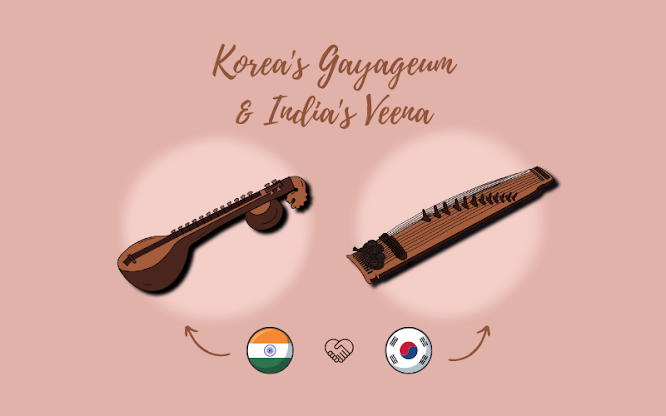Korea's Gayageum and India's Veena
As a lover of both Korean and Indian culture, I personally felt that there’s some beautiful connection/similarity between some of the traditional instruments of both the countries. I find the Gayageum and Veena to be fascinating instruments that embody the rich traditions and artistry of their respective countries. The Gayageum's delicate plucking and soothing melodies instantly transport me to the picturesque the ancient Korea, while the beautiful sound of the Veena evokes a sense of spiritual connection to the diverse heritage of India. Embracing these two instruments has deepened my appreciation for the depth and beauty of cultural expressions. One of the most rewarding aspects of exploring both the Gayageum and Veena has been the opportunity to connect with like-minded individuals who share the same passion for music and cultural exchange.
The Gayageum (12-string zither) and Veena are iconic musical instruments that hold deep cultural significance in their respective countries. While the Gayageum represents traditional Korean music, the Veena embodies the rich heritage of Indian classical music.
When I listened to some Gayageum music on YouTube, I immediately got reminded of Veena and it strings, sound, the way of sitting down to play the instrument, etc. So mainly these two are stringed instruments, which made me first to feel about the connection and make a good comparison out of these two and also going ahead with exploring some of the other comparable instruments. Come on! Enjoy reading the unique characteristics of each instrument and discover the similarities they share.
Look-wise and Music-wise Similarities of both Gayageum and Veena:
Exquisite Craftsmanship: Both the Gayageum and Veena are crafted with meticulous attention to detail, showcasing the craftsmanship of skilled artisans. They feature a distinctive curved shape, with the Gayageum having a trapezoidal wooden body and the Veena boasting a resonating gourd.
Stringed Instruments: The Gayageum and Veena are stringed instruments, played by plucking the strings with the fingers or using a pick. The strings are typically made of silk or metal, and their varying thickness produces a wide range of tones and melodies.
Melodic Versatility: Both instruments offer a vast tonal range and the ability to produce intricate melodies. The Gayageum is known for its delicate and expressive sound, with 12 strings that can be plucked individually or in combination to create captivating melodies. Similarly, the Veena is revered for its ability to evoke emotions through its resonant and soulful tones.
A Few More Comparable Instruments of Korea and India:
Janggu: The Janggu is a traditional Korean drum that finds its counterpart in the Indian Mridangam. These drums play a vital role in providing rhythmic accompaniment and enhancing the dynamics of traditional music performances in both cultures.
Haegeum: The Haegeum is a traditional Korean two-stringed fiddle that shares some similarities with the Indian Sarangi. Both instruments produce a rich and vibrant sound, and their intricate playing techniques allow for nuanced expression.
Daegeum: The Daegeum is a large bamboo flute in Korea, comparable to the Indian Bansuri. Both instruments are capable of producing hauntingly beautiful melodies, and their versatility allows for improvisation and intricate ornamentation.
Geomungo: The Geomungo is a traditional Korean zither instrument that shares similarities with the Indian Santoor. Both instruments feature a flat soundboard with strings stretched across it, and they are played by plucking the strings with specially designed mallets. The Geomungo and Santoor produce resonant and melodic tones, allowing for intricate musical compositions.
Ajaeng: The Ajaeng is a traditional Korean stringed instrument that can be compared to the Indian Dilruba. Both instruments feature a resonating body and strings that are played with a bow. The Ajaeng and Dilruba produce rich and captivating sounds, making them integral to the traditional music of their respective cultures.
Some of the instruments including Ajaeng highlight the diversity and richness of stringed instruments in both Korean and Indian music traditions. So, the Gayageum and Veena, along with their comparable counterparts, serve as cultural ambassadors, preserving the musical heritage of both countries. They not only showcase the incredible artistry and craftsmanship of their respective traditions but also provide a profound means of artistic expression.
Hope you readers love the illustration of me bringing the two countries’ traditional instruments together in a picture... <3 ^^




Comments
Post a Comment